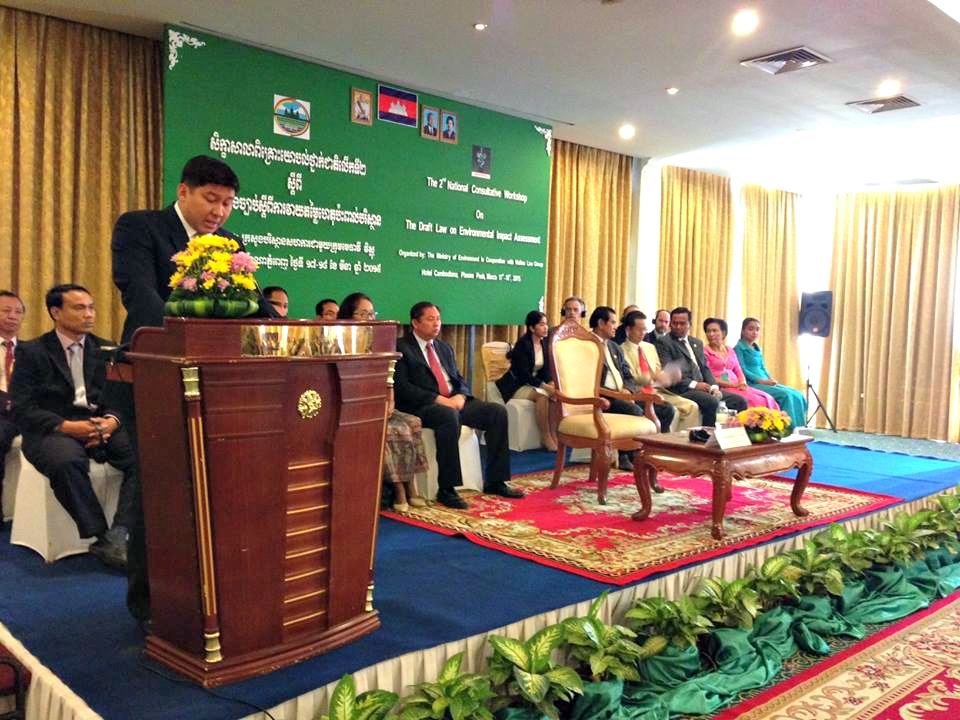តម្រូវការផ្នែកច្បាប់បឋមសម្រាប់ការវាយតម្លៃហេតុប៉ះពាល់បរិស្ថាន (EIA) នៅក្នុងប្រទេសកម្ពុជាត្រូវបានចែងក្នុងមាតិកាទី២ គន្ថីទី៥ នៃក្រមបរិស្ថាន និងធនធានធម្មជាតិ។1 ជំពូកទី ៣ នៃច្បាប់ស្តីពីការការពារបរិស្ថាន និងការគ្រប់គ្រងធនធានធម្មជាតិ ឆ្នាំ១៩៩៦2 និងអនុក្រឹត្យលេខ ៧២ ស្តីពីការវាយតម្លៃហេតុប៉ះពាល់បរិស្ថាន (១៩៩៩)។3
រដ្ឋធម្មនុញ្ញនៃព្រះរាជាណាចក្រកម្ពុជាចែងក្នុងមាត្រា ៥៩ ថា៖
“រដ្ឋត្រូវរក្សាការពារបរិស្ថាន និងតុល្យភាពនៃភោគទ្រព្យធម្មជាតិហើយត្រូវចាត់ចែងឱ្យមានផែនការច្បាស់លាស់ក្នុងការគ្រប់គ្រង មានជាអាទិ៍ ដីធ្លី ទឹក អាកាស ខ្យល់ ភូគព្ភសាស្ត្រ ប្រព័ន្ធអេកូឡូស៊ី រ៉ែ ថាមពល ប្រេងកាត និងឧស្ម័ន ថ្ម និងខ្សាច់ ត្បូងថ្ម ព្រៃឈើ និងអនុផលព្រៃឈើពពួកសត្វព្រៃ មច្ឆាជាតិ ធនធានជលផល។”4

រដ្ឋមន្ត្រីក្រសួងបរិស្ថាន ឯកឧត្តម សាយ សំអាល់ បានថ្លែងសុន្ទរកថា នៅក្នុងសិក្ខាសាលាពិគ្រោះយោបល់ថ្នាក់ជាតិ ស្តីពីសេចក្តីព្រាងច្បាប់ស្តីពីការវាយតម្លៃហេតុប៉ះពាល់បរិស្ថាន។ រូបភាពដោយអង្គការទិន្នន័យអំពីការអភិវឌ្ឍ ថតនៅថ្ងៃទី ១៧ ខែមីនា ឆ្នាំ ២០១៥។ ក្រោមអាជ្ញាប័ណ្ណ CC BY-SA 4.0
យោងតាមអនុក្រឹត្យ គម្រោងទាំងអស់ត្រូវតែឆ្លងកាត់ការវាយតម្លៃហេតុប៉ះពាល់បរិស្ថានដំបូង (IEIA) ដើម្បីកំណត់ថាតើគម្រោងនេះត្រូវបានការវាយតម្លៃហេតុប៉ះពាល់បរិស្ថាន ឬអត់។ ប្រទេសកម្ពុជាប្រកាន់ខ្ជាប់នូវជំហានដូចខាងក្រោមក្នុងដំណើរការការវាយតម្លៃហេតុប៉ះពាល់បរិស្ថានដំបូង/ការវាយតម្លៃហេតុប៉ះពាល់បរិស្ថាន៖
- ការត្រួតពិនិត្យគម្រោង
- ការធ្វើវិសាលភាពគម្រោង
- ការរៀបចំរបាយការណ៍ការវាយតម្លៃហេតុប៉ះពាល់បរិស្ថាន និងផែនការគ្រប់គ្រងបរិស្ថាន (EMP)
- ការពិនិត្យ និងវាយតម្លៃរបាយការណ៍ការវាយតម្លៃហេតុប៉ះពាល់បរិស្ថាន
- ការយល់ព្រមឬការបដិសេធរបាយការណ៍ការវាយតម្លៃហេតុប៉ះពាល់បរិស្ថាន
- សំណង់ប្រតិបត្តិការ
- ការត្រួតពិនិត្យតាមដានការអនុវត្ត និងការអនុវត្តគម្រោង។
យោងតាមក្របខ័ណ្ឌច្បាប់ស្តីពីកិច្ចការពារបរិស្ថាន និងការគ្រប់គ្រងធនធានធម្មជាតិឆ្នាំ១៩៩៦ រាល់ការអនុវត្តគម្រោងវិនិយោគ និងគម្រោងទាំងអស់ដែលស្នើដោយរដ្ឋ ត្រូវតែមានការវាយតម្លៃហេតុប៉ះពាល់បរិស្ថានដំបូង (IEIA) របាយការណ៍នៃការសិក្សាអំពីលទ្ធភាពជាមុន ឬការវាយតម្លៃហេតុប៉ះពាល់បរិស្ថានដូចមានចែងក្នុងច្បាប់ស្តីពីកិច្ចការពារបរិស្ថាន និងការគ្រប់គ្រងធនធានធម្មជាតិ (មាត្រា៦ និងមាត្រា៧)។5 ឯកសារថតចម្លងមួយច្បាប់ត្រូវបញ្ជូនទៅក្រសួង/ស្ថាប័នដែលអនុម័តគម្រោង និងក្រសួងបរិស្ថាន។
អនុក្រឹត្យស្តីលេខ ៧២ ពីកិច្ចដំណើរការវាយតម្លៃហេតុប៉ះពាល់បរិស្ថាន (១៩៩៩) តម្រូវឱ្យមានការវាយតម្លៃហេតុប៉ះពាល់បរិស្ថានមួយរាល់គ្រប់គម្រោងសាធារណៈឬឯកជន ដែលពាក់ព័ន្ធនឹងសកម្មភាពដែលមានចែងនៅក្នុងឧបសម្ព័ន្ធនៃអនុក្រឹត្យនេះ។ សកម្មភាពទាំងនោះរួមមាន គម្រោងកសិ-ឧស្សាហកម្ម រោងចក្រផ្នែកផលិតផលពីឈើ និងក្រដាស ការរុករករ៉ែ រោងចក្រសារធាតុគីមី វាយនភ័ណ្ឌ រោងចក្រថាមពល ទេសចរណ៍ និងហេដ្ឋារចនាសម្ព័ន្ធជាដើម។ ទោះជាយ៉ាងណា អនុក្រឹត្យនេះមានការលើកលែងលើ «គម្រោងទាំងឡាយណាដែលមានលក្ខណៈពិសេស និងមានសារៈសំខាន់ខ្លាំង ដែលសម្រេចដោយរាជរដ្ឋាភិបាល» (មាត្រា ២ និងឧបសម្ព័ន្ធ)។6
ផែនការជាតិ និងផែនការសកម្មភាពបរិស្ថានឆ្នាំ ២០១៦-២០២៣7 ត្រូវបានអនុម័តដោយរាជរដ្ឋាភិបាលក្នុងឆ្នាំ២០១៧ ស្របតាមមាត្រា៥៩នៃរដ្ឋធម្មនុញ្ញ “ដើម្បីជួយប្រទេសកម្ពុជាឱ្យសម្រេចបានគោលដៅអភិវឌ្ឍន៍ប្រកបដោយចីរភាព និងពង្រឹងកិច្ចសហប្រតិបត្តិការរវាងក្រសួងស្ថាប័ន និងអ្នកពាក់ព័ន្ធដែលទទួលខុសត្រូវចំពោះគោលដៅអភិវឌ្ឍន៍ប្រកបដោយចីរភាពដោយសារបញ្ហាបរិស្ថាន គឺជាបញ្ហាអន្តរវិស័យ”។ ផែនការជាតិ និងផែនការសកម្មភាពបរិស្ថាន គឺជាការប្តេជ្ញាចិត្តដើម្បីការអភិវឌ្ឍប្រកបដោយចីរភាព។ ចក្ខុវិស័យរបស់ផែនការជាតិ និងផែនការសកម្មភាពបរិស្ថានគឺដើម្បី “ពង្រឹងលក្ខន្តិកៈ និងអានុភាពសម្រាប់បរិស្ថាន និងការគ្រប់គ្រងធនធានធម្មជាតិ និងការអភិរក្សសម្រាប់ការអភិវឌ្ឍសេដ្ឋកិច្ច សង្គមប្រកបដោយចីរភាព និងស្ថេរភាពនៅកម្ពុជា” ។
ផែនការយុទ្ធសាស្ត្រការប្រែប្រួលអាកាសធាតុឆ្នាំ២០១៤-២០២៣8 បានកំណត់ការធ្វើបច្ចុប្បន្នភាពនៃច្បាប់ស្តីពីបរិស្ថាន និងច្បាប់ការវាយតម្លៃហេតុប៉ះពាល់បរិស្ថាន ដែលជាវិស័យអាទិភាពក្នុងការបញ្ជ្រាបការប្រែប្រួលអាកាសធាតុទៅក្នុងក្របខ័ណ្ឌបទប្បញ្ញត្តិនៃប្រទេសកម្ពុជា។ ច្បាប់នេះតម្រូវឱ្យមានការរួមបញ្ចូលការប្រែប្រួលអាកាសធាតុទៅក្នុងដំណើរការវាយតម្លៃហេតុប៉ះពាល់បរិស្ថានទៅក្នុងគម្រោងទាំងអស់។ ការដាក់បញ្ចូលការពិចារណាលើការប្រែប្រួលអាកាសធាតុទៅក្នុងក្របខ័ណ្ឌ ការវាយតម្លៃហេតុប៉ះពាល់បរិស្ថានត្រូវបានគេចាត់ទុកថាជាយុទ្ធសាស្ត្រអាទិភាព (៥.៣ គោលដៅ និងយុទ្ធសាស្ត្រ) ។
នៅថ្ងៃទី០៣ ខែកុម្ភៈ ឆ្នាំ២០២០ ក្រសួងបរិស្ថានបានចេញប្រកាសលេខ ០២១ ស្តីពីការចាត់ថ្នាក់នៃការវាយតម្លៃហេតុប៉ះពាល់បរិស្ថានសម្រាប់គម្រោងអភិវឌ្ឍន៍ ដែលជាការធ្វើបច្ចុប្បន្នភាពបន្ថែមលើអនុក្រឹត្យលេខ ៧២ ស្តីពីការវាយតម្លៃហេតុប៉ះពាល់បរិស្ថានចុះថ្ងៃទី១១ ខែសីហា ឆ្នាំ១៩៩៩ និងប្រកាសរួមលេខ ១៤២៨ ស្តីពីថ្លៃសេវាសាធារណៈចុះថ្ងៃទី២០ ខែវិច្ឆិកា ឆ្នាំ២០១៤ ដែលចេញដោយក្រសួងសេដ្ឋកិច្ច និងហិរញ្ញវត្ថុ និងក្រសួងសេដ្ឋកិច្ចនិងហិរញ្ញវត្ថុ។ ប្រកាសលេខ ០២១ មានគោលបំណងដែលមិនធ្លាប់មានពីមុនមក គឺដើម្បីចាត់ថ្នាក់គម្រោងវិនិយោគណាដែលជាកម្មវត្ថុនៃការវាយតម្លៃហេតុប៉ះពាល់បរិស្ថានដំបូង ឬការវាយតម្លៃហេតុប៉ះពាល់បរិស្ថានពេញលេញ ដោយផ្អែកលើលក្ខណៈនិង/ឬទំហំនៃគម្រោង។ គួរកត់សម្គាល់ផងដែរថា ក្នុងប្រកាសលេខ០២១ សំណួរថាតើការវាយតម្លៃហេតុប៉ះពាល់បរិស្ថានដំបូង ឬការវាយតម្លៃហេតុប៉ះពាល់បរិស្ថានពេញលេញត្រូវបានទាមទារសម្រាប់គម្រោងជាក់លាក់ណាមួយ ដែលសំណួរនេះពិបាកសម្រេច ហើយជាទូទៅត្រូវមានការបញ្ជាក់ពីក្រសួងបរិស្ថានលើករណីនីមួយៗដោយផ្អែកលើករណីនីមួយៗ។ គោលដៅនៃប្រកាសនេះគឺ ការចាត់ថ្នាក់នៃការវាយតម្លៃហេតុប៉ះពាល់បរិស្ថានសម្រាប់គម្រោងអភិវឌ្ឍន៍ដែលតម្រូវឱ្យមានកិច្ចសន្យាការពារបរិស្ថាន ឬការវាយតម្លៃហេតុប៉ះពាល់បរិស្ថានដំបូង ឬការវាយតម្លៃហេតុប៉ះពាល់បរិស្ថានពេញលេញ។ ប្រកាសនេះត្រូវបានអនុវត្តចំពោះរាល់សំណើរនៃគម្រោងអភិវឌ្ឍន៍ដែលរួមមានគម្រោងដែលមានស្រាប់ និងកំពុងបន្តរបស់បុគ្គល ឯកជន រឺក្រុមហ៊ុនឯកជន ក្រុមហ៊ុនបណ្តាក់ទុនរួមគ្នា ក្រុមហ៊ុនសាធារណៈ ឬក្រសួង ឬទីភ្នាក់ងាររបស់រដ្ឋាភិបាល។
ព្រះមហាក្សត្របានឡាយព្រះហស្តលេខាលើក្រមបរិស្ថាន និងធនធានធម្មជាតិ នៅថ្ងៃទី២៩ ខែមិថុនា ឆ្នាំ២០២៣ ហើយក្រមនេះនឹងត្រូវបានយកទៅអនុវត្តក្នុងរយៈពេលមួយឆ្នាំ ក្រោយការចូលជាធរមាននៃក្រមនេះ។9 ក្រមនេះត្រូវបានតាក់តែងឡើងដោយផ្អែកលើលិខិតបទដ្ឋានគតិយុត្តក្នុងវិស័យបរិស្ថាន និងធនធានធម្មជាតិ ដែលត្រូវបានធ្វើសមាហរណកម្ម សុខដុមនីយកម្ម និងធ្វើទំនើបកម្ម ឱ្យឆ្លើយតបនឹងនិន្នាការវិវត្តន៍នៃសង្គម។ ក្រមថ្មីនេះ ក៏ដូចជាច្បាប់របស់កម្ពុជាទាំងអស់ គឺត្រូវគោរពតាមរដ្ឋធម្មនុញ្ញ ដែលរួមបញ្ចូលតម្រូវការសម្រាប់ការការពារបរិស្ថាន។ គន្លីទី៥ “ការវាយតម្លៃបរិស្ថាន” មានមាតិកាពីរគឺ ការវាយតម្លៃបរិស្ថានជាយុទ្ធសាស្ត្រ (SEA) និង ការវាយតម្លៃហេតុប៉ះពាល់បរិស្ថាន (EIA) ដែលមាន ៨០ មាត្រា (១១ មាត្រានៃ SEA និង ៦៩ មាត្រានៃ EIA)។ ការអនុវត្ត SEA អនុញ្ញាតឱ្យអ្នកធ្វើសេចក្តីសម្រេចចិត្តពិចារណាជម្រើសដ៏ទូលំទូលាយមួយ ដោយកាត់បន្ថយបញ្ហាដែលអាចកើតមាននៅដំណាក់កាលដំបូង។
ដំណើរការរបស់ការវាយតម្លៃហេតុប៉ះពាល់បរិស្ថាន
មានក្រុមហ៊ុនពិគ្រោះយោបល់ដើម្បីរកប្រាក់ចំណេញជាច្រើនដែលផ្សាយពាណិជ្ជកម្មសេវាកម្មរបស់ពួកគេក្នុងការធ្វើការវាយតម្លៃហេតុប៉ះពាល់បរិស្ថាន។ សេវាកម្មទាំងនេះធ្វើការដោយផ្ទាល់សម្រាប់ក្រុមហ៊ុនគម្រោង។ នាយកដ្ឋានវាយតម្លៃហេតុប៉ះពាល់បរិស្ថាននៅក្នុងក្រសួងបរិស្ថានពិនិត្យមើលរបាយការណ៍នេះ ប៉ុន្តែមិនមែនជាអ្នកធ្វើរបាយការណ៍ដោយខ្លួនឯងទេ។ ក្រៅពីម្ចាស់គម្រោង អ្នកពិគ្រោះយោបល់ការវាយតម្លៃហេតុប៉ះពាល់បរិស្ថាន និងអាជ្ញាធរបរិស្ថាន គឺជាតួអង្គពីរដែលមានឥទ្ធិពលយ៉ាងខ្លាំងទៅលើគុណភាពនៃហេតុប៉ះពាល់បរិស្ថាន។
យោងតាមប្រកាសលេខ ៣៧៦ ស្តីពីប្រកាសស្តីពីគោលការណ៍ណែនាំទូទៅសម្រាប់ធ្វើរបាយការណ៍វាយតម្លៃហេតុប៉ះពាល់បរិស្ថានដំបូងនិងពេញលេញ10 នៅពេលដែលការវាយតម្លៃហេតុប៉ះពាល់បរិស្ថានដំបូង ឬការវាយតម្លៃហេតុប៉ះពាល់បរិស្ថានពេញលេញត្រូវបានដាក់ជូនក្រសួង វាត្រូវតែវាយតម្លៃក្នុងរយៈពេល ៣០ ថ្ងៃ។ ក្នុងពេលវេលានេះ គេតម្រូវឱ្យមានការចុះពិនិត្យទីតាំង និងពិគ្រោះយោបល់ជាមួយអ្នកដែលរងផលប៉ះពាល់គម្រោង និងអ្នកពាក់ព័ន្ធដទៃទៀត។ មាត្រា ៩ ចែងថាមន្ទីរជាតិ ឬខេត្តដែលពាក់ព័ន្ធត្រូវពិនិត្យ និងផ្តល់យោបល់លើរបាយការណ៍ការវាយតម្លៃហេតុប៉ះពាល់បរិស្ថានដំបូង ឬរបាយការណ៍ការវាយតម្លៃហេតុប៉ះពាល់បរិស្ថានពេញលេញ។
បន្ទាប់ពីការត្រួតពិនិត្យបច្ចេកទេស គេនឹងធ្វើការប្រជុំពហុភាគីពាក់ព័ន្ធបន្ថែមទៀត ដែលរួមមានក្រសួងផ្សេងទៀត និងអ្នកពាក់ព័ន្ធ ដែលក្នុងអំឡុងពេលនោះអនុសាសន៍នឹងត្រូវបានពិចារណា។ បន្ទាប់ពីកិច្ចប្រជុំនេះ អនុសាសន៍ចុងក្រោយត្រូវបានដាក់ជូនរដ្ឋមន្ត្រីក្រសួងបរិស្ថានថា តើត្រូវយល់ព្រម ឬបដិសេធការវាយតម្លៃហេតុប៉ះពាល់បរិស្ថានដំបូង ឬការវាយតម្លៃហេតុប៉ះពាល់បរិស្ថានពេញលេញ។ ប្រសិនបើត្រូវបានអនុម័ត វិញ្ញាបនប័ត្រអនុម័ត ការវាយតម្លៃហេតុប៉ះពាល់បរិស្ថា នឹងត្រូវបានចេញរួមគ្នាជាមួយនឹងល័ក្ខខ័ណ្ឌណាមួយដែលត្រូវបានដាក់លើគម្រោង។

កិច្ចដំណើរការនៃការវាយតម្លៃហេតុប៉ះពាល់បរិស្ថាន សម្រាប់គម្រោងស្នើសុំដែលអនុម័តដោយស្ថាប័នអនុម័តគម្រោង ឬអនុគណៈកម្មាធិការវិនិយោគខេត្ត ពីប្រកាសស្តីពីគោលការណ៍ណែនាំទូទៅ ឆ្នាំ២០០៩។
នៅប្រទេសកម្ពុជា វេទិកានៃអង្គការមិនមែនរដ្ឋាភិបាលស្តីពីកម្ពុជា (NGOF) និងបណ្តាញ EISEI របស់អង្គការការអភិវឌ្ឍន៍ និងភាពជាដៃគូក្នុងសកម្មភាព (DPA) ដើរតួនាទីយ៉ាងសំខាន់ក្នុងការសម្របសម្រួលដល់អង្គការសង្គមស៊ីវិលក្នុងការផ្តល់មតិទៅលើរបាយការណ៍ការវាយតម្លៃហេតុប៉ះពាល់បរិស្ថាន បន្ទាប់ពីពួកគេទទួលបានសេចក្តីព្រាងរបាយការណ៍ពីក្រសួងបរិស្ថាន។
ការត្រួតពិនិត្យតាមដាន
អនុក្រឹត្យលេខ ៧២ ស្តីពីកិច្ចដំណើរការវាយតម្លៃហេតុប៉ះពាល់បរិស្ថាន ផ្តល់ការទទួលខុសត្រូវពេញលេញដល់ក្រសួងបរិស្ថាន ដើម្បីអង្កេតតាមដានគម្រោង។11 ការអង្កេតតាមដាន គួរធ្វើក្នុងអំឡុងពេលនៃការសាងសង់ ការប្រតិបត្តិការ និងការបញ្ចប់គម្រោង។12 នាយកដ្ឋានត្រួតពិនិត្យ និងវាយតម្លៃហេតុប៉ះពាល់បរិស្ថាន គឺជាអ្នកទទួលខុសត្រូវចំពោះការពិនិត្យ និងមានតួនាទីទៅលើការពិនិត្យរបាយការណ៍វាយតម្លៃហេតុប៉ះពាល់បរិស្ថាន។ ស្ថាប័នដែលទទួលខុសត្រូវចំពោះការអនុម័តគម្រោង អាចប្រព្រឹត្តទៅបានបន្ទាប់ពីការពិចារណាលើការរកឃើញលទ្ធផល និងអនុសាសន៍ពីក្រសួងបរិស្ថាន។13
ទំនួលខុសត្រូវក្នុងការតាមដាន ការអនុលោមតាម និងការអនុវត្តត្រូវបានបែងចែករវាងភាគីនានា អាស្រ័យទៅលើកម្រិតនៃរដ្ឋាភិបាល (ថ្នាក់ជាតិ ឬខេត្ត) ដែលជាស្ថាប័នអនុម័តសម្រាប់គម្រោងនេះ។ បទប្បញ្ញត្តិសម្រាប់ការតាមដាន ការកត់ត្រារក្សា និងការត្រួតពិនិត្យក៏ត្រូវបានរកឃើញនៅក្នុងច្បាប់ស្តីពីការការពារបរិស្ថាននិងការគ្រប់គ្រងធនធានធម្មជាតិ ផងដែរ។14 ក្នុងជំពូក ៦ ក្រសួងបរិស្ថានគឺត្រូវសហការជាមួយក្រសួងពាក់ព័ន្ធដទៃទៀតក្នុងការតាមដាន កត់ត្រារក្សា និងត្រួតពិនិត្យ (សូមមើលមាត្រា ១៤ និង ១៥)។ ក្នុងមាត្រា ១៥ មានចែងពីកាតព្វកិច្ចរបស់អ្នកត្រួតពិនិត្យថា ត្រូវរាយការណ៍ទៅស្ថាប័នពាក់ព័ន្ធអំពីការរំលោភណាមួយ ដើម្បីចាត់វិធានការស្របតាមច្បាប់។
បញ្ហាប្រឈម
ការទទួលបានរបាយការណ៍ការវាយតម្លៃហេតុប៉ះពាល់បរិស្ថាននៅមានកម្រិត គឺជាបញ្ហាប្រឈមដ៏ធំបំផុតមួយសម្រាប់សាធារណជនក្នុងការផ្តល់យោបល់លើរបាយការណ៍ការវាយតម្លៃហេតុប៉ះពាល់បរិស្ថាន និងធានាឱ្យមានការពិគ្រោះយោបល់ដែលប្រកបដោយអត្ថន័យ។ គិតត្រឹមឆ្នាំ២០២០ នៅក្នុងគេហទំព័របើកទូលាយសម្រាប់ឯកសារទាក់ទងនឹងគម្រោងការត្រួតពិនិត្យបរិស្ថានដំបូង ឬរបាយការណ៍ការវាយតម្លៃហេតុប៉ះពាល់បរិស្ថានរបស់អ្នកចូលរួមគម្រោង គឺមិនអាចចូលទៅប្រើប្រាស់ដោយងាយនោះទេ។ បើទោះបីជាក្រសួងបរិស្ថានមានទំនួលខុសត្រូវក្នុងការផ្តល់ព័ត៌មានទាក់ទងនឹងគម្រោងក៏ពិតមែន ប៉ុន្តែជារឿយៗ នៅពេលមានតម្រូវការ ឥរិយាបថរបស់មន្ត្រីការផ្តល់ព័ត៌មានហាក់ដូចជាមានការស្ទាក់ស្ទើរ។ ដោយសំអាងថា ការងារនេះត្រូវប្រើពេលវេលាយូរ និងការទទួលយកមតិយោបល់ត្រលប់ទៅវិញមានកម្រិតទាប វាត្រូវបានគេរំពឹងថាមានប្រជាជនក្នុងស្រុកមួយចំនួនតូចប៉ុណ្ណោះដែលសុខចិត្តឆ្លងកាត់ដំណើរការលំបាកក្នុងការទទួលបានឯកសារ ហើយពួកគេប្រហែលជាពិបាកយល់ បើទោះបីជាគេអាចស្វែងរកបានឯកសារក៏ដោយ។
វាត្រូវបានគេទទួលស្គាល់ថា ក្របខណ្ឌច្បាប់របស់ប្រទេសកម្ពុជា សម្រាប់ធ្វើការវាយតម្លៃហេតុប៉ះពាល់បរិស្ថាន គឺមិនមានលក្ខណៈពេញលេញនោះទេ ហើយច្បាប់ស្តីពីការវាយតម្លៃហេតុប៉ះពាល់បរិស្ថាន ក៏កំពុងស្ថិតក្នុងដំណើរការពង្រាង។ ប៉ុន្តែបញ្ហាប្រឈមជាក់ស្តែង នៅកើតមានក្នុងការធានាថា សុចរិតភាពនៃដំណើរការរបស់ការវាយតម្លៃហេតុប៉ះពាល់បរិស្ថានត្រូវបានអនុលោមតាម។ អ្នកសង្កេតការមួយរូប ពោលថា «តម្រូវការសម្រាប់ការវាយតម្លៃបរិស្ថាននៅប្រទេសកម្ពុជា នៅតែត្រូវបានគេចាត់ទុកជាទូទៅថា ជាតម្រូវការបន្ទាប់បន្សំសម្រាប់ការអភិវឌ្ឍ។ សារៈសំខាន់នៃការវាយតម្លៃហេតុប៉ះពាល់បរិស្ថាន មិនទាន់ត្រូវបានទទួលស្គាល់យ៉ាងពេញលេញ តួយ៉ាងក្រសួងនានានៃរាជរដ្ឋាភិបាល ដែលទទួលបន្ទុកលើការអភិវឌ្ឍហេដ្ឋារចនាសម្ព័ន្ធ ឧស្សាហកម្ម និងកសិកម្ម»។15 គម្រោងមួយចំនួនបានចាប់ផ្តើមសកម្មភាព ខណៈពេលដែលការវាយតម្លៃហេតុប៉ះពាល់បរិស្ថាននៅកំពុងដំណើរការ និងគម្រោងមួយចំនួនទៀត បានធ្វើការវាយតម្លៃហេតុប៉ះពាល់បរិស្ថាន ប៉ុន្តែមិនត្រូវបានដាក់បង្ហាញជាសាធារណៈឡើយ។
តម្រូវការថ្មីសម្រាប់ការវាយតម្លៃហេតុប៉ះពាល់ឆ្លងព្រំដែន ការវាយតម្លៃបរិស្ថានជាយុទ្ធសាស្ត្រ និងការពិចារណាលើការប្រែប្រួលអាកាសធាតុក្នុងការគ្រប់គ្រងបរិស្ថានដែលមានចែងនៅក្នុងសេចក្តីព្រាងក្រមបរិស្ថាន និងធនធានធម្មជាតិអាចប្រឈមនឹងបញ្ហាក្នុងការអនុវត្តនាពេលអនាគត។
ទាក់ទងនឹងការវាយតម្លៃហេតុប៉ះពាល់បរិស្ថាន
- គោលនយោបាយ និងការគ្រប់គ្រងបរិស្ថាន និងធនធានធម្មជាតិ
- ទំនប់វារីអគ្គីសនី
- ការប្រែប្រួលអាកាសធាតុ
- ការវាយតម្លៃបរិស្ថានជាយុទ្ធសាស្ត្រក្នុងប្រទេសកម្ពុជា
បច្ចុប្បន្នភាពចុងក្រោយ៖ ថ្ងៃទី០៤ ខែសីហា ឆ្នាំ២០២៣
ឯកសារយោង
- 1. រាជរដ្ឋាភិបាលកម្ពុជា, “ក្រមបរិស្ថាន និងធនធានធម្មជាតិ,” ថ្ងៃទី២៩ ខែមិថុនា ឆ្នាំ២០២៣, បានចូលអាននៅថ្ងៃទី០៣ ខែសីហា ឆ្នាំ២០២៣
- 2. រាជរដ្ឋាភិបាលកម្ពុជា, “ច្បាប់ស្តីពីការការពារបរិស្ថាននិងការគ្រប់គ្រងធនធានធម្មជាតិ,” ថ្ងៃទី២៤ ខែធ្នូ ឆ្នាំ១៩៩៦ (មាត្រា ៦ និង ៧), បានចូលអាននៅថ្ងៃទី០៣ ខែសីហា ឆ្នាំ២០២៣។
- 3. រដ្ឋាភិបាលកម្ពុជា, “អនុក្រឹត្យស្តីពីដំណើរការវាយតម្លៃហេតុប៉ះពាល់បរិស្ថាន,” ថ្ងៃទី១១ ខែសីហា ឆ្នាំ១៩៩៩ បានចូលអានថ្ងៃទី០៣ ខែសីហា ឆ្នាំ២០២៣។
- 4. “រដ្ឋធម្មនុញ្ញនៃព្រះរាជាណាចក្រកម្ពុជា,” ឆ្នាំ១៩៩៣ (មាត្រា ៥៩)។
- 5. រាជរដ្ឋាភិបាលកម្ពុជា “ច្បាប់ស្តីពីការការពារបរិស្ថាននិងការគ្រប់គ្រងធនធានធម្មជាតិ,” ថ្ងៃទី២៤ ខែធ្នូ ឆ្នាំ១៩៩៦, បានចូលអាននៅថ្ងៃទី០៣ ខែសីហា ឆ្នាំ២០២៣។
- 6. រាជរដ្ឋាភិបាលកម្ពុជា “អនុក្រឹត្យលេខ ៧២ ស្តីពីកិច្ចដំណើរការវាយតម្លៃហេតុប៉ះពាល់បរិស្ថាន,” ថ្ងៃទី២៤ ខែធ្នូ ឆ្នាំ១៩៩៦ (មាត្រា ២ និងឧបសម្ព័ន្ធ), បានចូលអាននៅថ្ងៃទី០៣ ខែសីហា ឆ្នាំ២០២៣។
- 7. រាជរដ្ឋាភិបាលកម្ពុជា, “ផែនការជាតិនិងផែនការសកម្មភាពបរិស្ថានឆ្នាំ ២០១៦-២០២៣,” ឆ្នាំ២០១៧, បានចូលអានថ្ងៃទី០៣ ខែសីហា ឆ្នាំ២០២៣។
- 8. គណៈកម្មាធិការជាតិគ្រប់គ្រងការប្រែប្រួលអាកាសធាតុ “ផែនការយុទ្ធសាស្ត្រការប្រែប្រួលអាកាសធាតុឆ្នាំ២០១៤-២០២៣,” ឆ្នាំ២០១៣, បានចូលអានថ្ងៃទី០៣ ខែសីហា ឆ្នាំ២០២៣។
- 9. រាជរដ្ឋាភិបាលកម្ពុជា, “ព្រះរាជក្រមលេខ នស/រកម/០៦២៣/០០៧ ស្តីពីក្រមបរិស្ថាននិងធនធានធម្មជាតិ,” ថ្ងៃទី២៩ ខែមិថុនា ឆ្នាំ២០២៣, បានចូលអាននៅថ្ងៃទី០៣ ខែសីហា ឆ្នាំ២០២៣។
- 10. ក្រសួងបរិស្ថាន, “ប្រកាសលេខ ៣៧៦ ស្តីពីគោលការណ៍ណែនាំទូទៅសម្រាប់ធ្វើរបាយការណ៍វាយតម្លៃផលប៉ះពាល់បរិស្ថានដំបូងនិងពេញលេញ,” ថ្ងៃទី០២ ខែកញ្ញា ឆ្នាំ២០០៩, បានចូលអាននៅថ្ងៃទី០៣ ខែសីហា ឆ្នាំ២០២៣។
- 11. Schulte, W., Stetser, A, “នៅលើមាគ៌ាឆ្ពោះទៅរកការអភិវឌ្ឍប្រកបដោយចីរភាព៖ ការវាយតម្លៃលើសេចក្តីព្រាងច្បាប់ស្តីពីការវាយតម្លៃផលប៉ះពាល់បរិស្ថានរបស់ប្រទេសកម្ពុជា,” ឆ្នាំ២០១៤ បានចូលអានថ្ងៃទី០៣ ខែសីហា ឆ្នាំ២០២៣។
- 12. រាជរដ្ឋាភិបាលកម្ពុជា, “អនុក្រឹត្យលេខ ៧២ ស្តីពីកិច្ចដំណើរការវាយតម្លៃហេតុប៉ះពាល់បរិស្ថាន,” ថ្ងៃទី១១ ខែសីហា ឆ្នាំ១៩៩៩ (មាត្រា៣), បានចូលអាននៅថ្ងៃទី០៣ ខែសីហា ឆ្នាំ២០២៣។
- 13. ដូចឯកសារយោងខាងដើម (មាត្រា ៤)។
- 14. រាជរដ្ឋាភិបាលកម្ពុជា, “ច្បាប់ស្តីពីការការពារបរិស្ថាន និងការគ្រប់គ្រងធនធានធម្មជាតិ,” ថ្ងៃទី២៤ ខែធ្នូ ឆ្នាំ១៩៩៦, បានចូលអាននៅថ្ងៃទី០៣ ខែសីហា ឆ្នាំ២០២៣។
- 15. សំ ចំរើន, “ការអភិវឌ្ឍធនធានទឹកកម្ពុជា៖ ការពិនិត្យឡើងវិញនៃគោលនយោបាយ និងក្របខ័ណ្ឌច្បាប់ដែលមានស្រាប់,” ឆ្នាំ២០០៧, បានចូលអាននៅថ្ងៃទី០៣ ខែសីហា ឆ្នាំ២០២៣។

